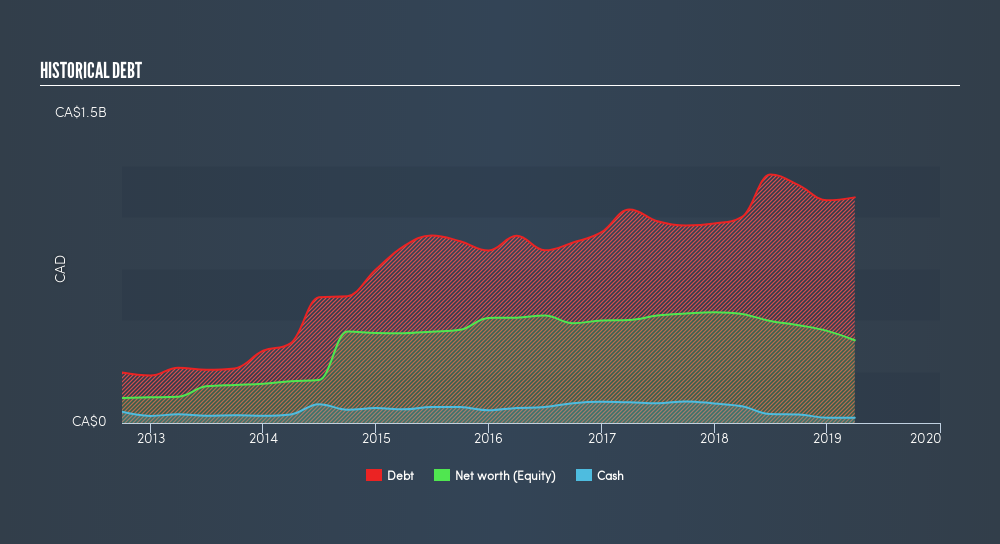
Want to participate in a short research study? Help shape the future of investing tools and you could win a $250 gift card!
Howard Marks put it nicely when he said that, rather than worrying about share price volatility, 'The possibility of permanent loss is the risk I worry about... and every practical investor I know worries about.' When we think about how risky a company is, we always like to look at its use of debt, since debt overload can lead to ruin. As with many other companies. AutoCanada Inc. (TSE:ACQ) makes use of debt. But the more important question is: how much risk is that debt creating?
Why Does Debt Bring Risk?
Generally speaking, debt only becomes a real problem when a company can't easily pay it off, either by raising capital or with its own cash flow. Part and parcel of capitalism is the process of 'creative destruction' where failed businesses are mercilessly liquidated by their bankers. However, a more common (but still painful) scenario is that it has to raise new equity capital at a low price, thus permanently diluting shareholders. Of course, the upside of debt is that it often represents cheap capital, especially when it replaces dilution in a company with the ability to reinvest at high rates of return. The first thing to do when considering how much debt a business uses is to look at its cash and debt together.
See our latest analysis for AutoCanada
How Much Debt Does AutoCanada Carry?
As you can see below, at the end of March 2019, AutoCanada had CA$1.10b of debt, up from CA$1.00b a year ago. Click the image for more detail. However, it also had CA$25.9m in cash, and so its net debt is CA$1.07b.

How Strong Is AutoCanada's Balance Sheet?
We can see from the most recent balance sheet that AutoCanada had liabilities of CA$954.8m falling due within a year, and liabilities of CA$667.2m due beyond that. Offsetting this, it had CA$25.9m in cash and CA$168.8m in receivables that were due within 12 months. So it has liabilities totalling CA$1.43b more than its cash and near-term receivables, combined.
The deficiency here weighs heavily on the CA$308.2m company itself, as if a child were struggling under the weight of an enormous back-pack full of books, his sports gear, and a trumpet. So we'd watch its balance sheet closely, without a doubt After all, AutoCanada would likely require a major re-capitalisation if it had to pay its creditors today. Because it carries more debt than cash, we think it's worth watching AutoCanada's balance sheet over time.
We use two main ratios to inform us about debt levels relative to earnings. The first is net debt divided by earnings before interest, tax, depreciation, and amortization (EBITDA), while the second is how many times its earnings before interest and tax (EBIT) covers its interest expense (or its interest cover, for short). The advantage of this approach is that we take into account both the absolute quantum of debt (with net debt to EBITDA) and the actual interest expenses associated with that debt (with its interest cover ratio).
AutoCanada shareholders face the double whammy of a high net debt to EBITDA ratio (16.1), and fairly weak interest coverage, since EBIT is just 1.01 times the interest expense. The debt burden here is substantial. Even worse, AutoCanada saw its EBIT tank 51% over the last 12 months. If earnings continue to follow that trajectory, paying off that debt load will be harder than convincing us to run a marathon in the rain. The balance sheet is clearly the area to focus on when you are analysing debt. But ultimately the future profitability of the business will decide if AutoCanada can strengthen its balance sheet over time. So if you want to see what the professionals think, you might find this free report on analyst profit forecasts to be interesting.
Finally, a business needs free cash flow to pay off debt; accounting profits just don't cut it. So we clearly need to look at whether that EBIT is leading to corresponding free cash flow. Over the most recent three years, AutoCanada recorded free cash flow worth 53% of its EBIT, which is around normal, given free cash flow excludes interest and tax. This free cash flow puts the company in a good position to pay down debt, when appropriate.
Our View
On the face of it, AutoCanada's EBIT growth rate left us tentative about the stock, and its level of total liabilities was no more enticing than the one empty restaurant on the busiest night of the year. But on the bright side, its conversion of EBIT to free cash flow is a good sign, and makes us more optimistic. After considering the datapoints discussed, we think AutoCanada has too much debt. While some investors love that sort of risky play, it's certainly not our cup of tea. Given the risks around AutoCanada's use of debt, the sensible thing to do is to check if insiders have been unloading the stock.
At the end of the day, it's often better to focus on companies that are free from net debt. You can access our special list of such companies (all with a track record of profit growth). It's free.
We aim to bring you long-term focused research analysis driven by fundamental data. Note that our analysis may not factor in the latest price-sensitive company announcements or qualitative material.
If you spot an error that warrants correction, please contact the editor at editorial-team@simplywallst.com. This article by Simply Wall St is general in nature. It does not constitute a recommendation to buy or sell any stock, and does not take account of your objectives, or your financial situation. Simply Wall St has no position in the stocks mentioned. Thank you for reading.
About TSX:ACQ
AutoCanada
Through its subsidiaries, operates franchised automobile dealerships and related business.
Good value slight.
Similar Companies
Market Insights
Community Narratives





